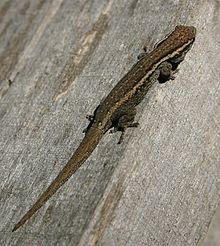Cape dwarf gecko
| Cape dwarf gecko | |
|---|---|

| |
| Gauteng, South Africa | |
| Scientific classification | |
| Kingdom: | |
| Phylum: | |
| Class: | |
| Order: | |
| Family: | |
| Genus: | |
| Species: | L. capensis
|
| Binomial name | |
| Lygodactylus capensis (Smith, 1849)
| |
| Subspecies | |
| |
| Synonyms | |
| |
The Cape dwarf gecko (Lygodactylus capensis) is a species of dwarf gecko found in the woodlands and forests of central and southern Africa (Republic of South Africa, Botswana, Swaziland, Democratic Republic of the Congo, Zambia, Angola, Namibia, Mozambique, Tanzania, Pemba Island).[1] They are often seen on garden walls in towns and cities.
Description
Length (snout to vent length) is 39 mm for males, 43 mm for females. Throat is stippled with grey or brown while the belly is cream coloured. The back is grey-brown with dark streak from snout to shoulder or beyond.[2] Its tail is remarkable for having the underside covered in adhesive lamellae enabling its use as a fifth limb. [3] When moulting it actively assists the process by detaching skin flakes and consuming them. It is sometimes kept as a pet.
References
- Smith, A. (1848). Illustrations of the zoology of South Africa, Reptilia. Smith, Elder & Co., London.
- Spawls, S.; Howell, K.; Drewes, R.C. & Ashe, J. (2001). A field guide to the reptiles of East Africa. Academic Press, 543 pp.
External links
 Media related to Lygodactylus capensis at Wikimedia Commons
Media related to Lygodactylus capensis at Wikimedia Commons- Lygodactylus capensis, GeckoList
